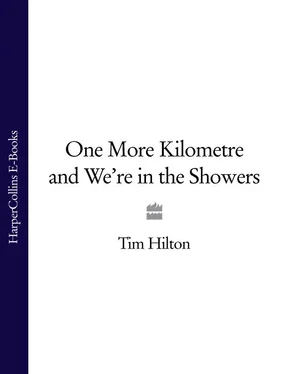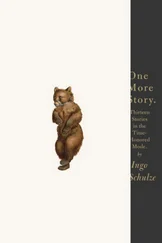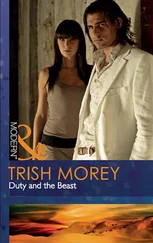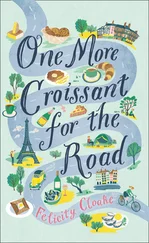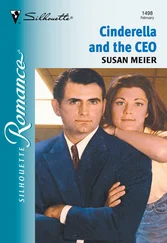The cycling figure is surely formed from two more familiar icons. The first is the scholar-gypsy, who, as we know, flits from river to inn to hilly path. The second is the wandering minstrel. Why do minstrels wander? Any bright young Birmingham Marxist of the 1950s will immediately put his hand up with the answer. It is because they have been expelled, by capitalism, from their true home in the feudal hall, and so must endlessly travel, with no warm place to lay their heads and few people to hear their melancholy song. Sir Walter Scott will tell you the same story. And, as the cycling poet recounts,
His head on his battered musette, a dreamy look in his eye, The cyclist lay by the roadside, watching the world go by.
And his mind went off on a journey, to the land of make-believe,
Where the laws no longer run that bind the sons of Adam and Eve.
Etymologically, the French musette means, originally, a sheep’s bladder; then, a bag; then, a primitive form of bagpipes, made from the bladder; and so we have the more familiar notion of the bal-musette , a rustic dance or jolly occasion in some quartier where country met city, and in which the ceremonies were led by traditional and informal music.
For the modern cyclist, a musette is a small fabric bag slung over the back for carrying provisions such as maps, Mars bars, ‘speed mixture’ (which is a cake of prunes and rice that wards off the bonk), amphetamines, inner tubes. British cyclists often call them ‘bonk bags’ * . Leaguers made them from that striped material used in deck chairs. In long races musettes containing food are handed up to riders by someone at the roadside. The professionals then throw them away, while the rest of us fold musettes and keep them in the pocket of a road jersey. I always carry one, just in case; and in autumn days I use a musette to ride home with shaggy woodland parasol mushrooms, or perhaps a pheasant that has been struck dead by some murdering bourgeois in a big black car. A freshly killed pheasant in a musette gives a little warm nudge to the lower vertebrae, a strange feeling that I suppose is known only to cyclists – and poachers, now I come to think of it.
*‘The bonk’ is a cycling term for a sudden loss of power and energy. It is accompanied by depression and sometimes tears. The condition is unknown to other sports and therefore to anyone who is not a cyclist. It can hit you very suddenly, when a cyclist will say ‘I’ve blown’. There are many other demotic terms. We speak of ‘The knock’, ‘hunger knock’, ‘the sags’, and fear the time when ‘Old Mr Saggy comes knocking at the door’. The rather official French word is défaillance. Bonk is caused by a lowering of the blood sugar level. The remedy is in food and drink. Hardriders always carry bonk bars, in former days prepared to gruesome recipes. Try oats slowly baked with syrup, lard, margarine and cocoa powder, together with chopped mixed fruits previously soaked in Guinness. But never eat anything that will make your handlebars sticky. Always have a bonk bar after two hours, even if you’re not hungry. The first time my son had the bonk (aged 12) I got him home, my arm around his shoulders. Then he had four giant helpings of Coco-Pops and milk before falling asleep, still wearing track mitts. No bonk is worse than the bonk you suffered as a teenager.
The connection between cycling and Georgian rolling-road mythology found a visual poetry in the art of Frank Patterson, which captures the spirit of cycling in the years before the motor car occupied our highways and byways. Patterson drew illustrations for cycling magazines for half a century. His career coincided with the period of the bicycle’s most popular appeal. Drawings by Patterson first appeared in Cycling in 1893. They filled its pages until his death in 1952 and are still reproduced, for this unique artist had neither a rival nor a successor.
It is said that Patterson produced some 26,000 drawings for publication. I believe this figure. Patterson was fluent, regular and knew exactly what he was about. His style, established early in life, was constant. Very thin pen lines, often elongated, each line close to the next, describe rural scenes, landscapes and quaint country buildings. Patterson never used cross-hatching or a wash. His line, though not distinguished, did everything he needed. The original drawings were three or four times larger than their published reproductions, so readers of Cycling and the CTC Gazette marvelled at his virtuoso penmanship.
Patterson’s drawings always included a cyclist or a bicycle. They depicted the things that old-fashioned cyclists like – a drovers’ road over Welsh hills, Lakeland passes and Peak District rough-stuff tracks, the Great North Road at Eaton Socon, so familiar to time triallists; market towns with coaching inns; castles, wishing wells, thatched country pubs, the Roman Wall, remote parish churches and the final miles home by moonlight.
Sometimes Patterson would make it clear that the cyclist who appeared in his drawing, speeding along traffic-free roads, was riding in a time trial. This was the only kind of cycle sport that he drew. He never shows us a massed-start race, a track meeting or a club run. His cyclists are usually alone. Occasionally they are in pairs or greet each other at crossroads. Very rarely, Patterson allowed a woman cyclist to appear, invariably on the back of a tandem.
‘Pat’, as he was called by his few intimates, had an enormous but imprecise effect on the nature of English cycling. Both he and his near contemporary Robert Blatchford, founder of The Clarion (Blatchford 1851–1943, Patterson 1871–1952), were journalists who established the mood of their era. They did not resemble each other. Blatchford knew that cycling meant comradeship, escape from the city, political optimism, tandems, marriage, the future. Patterson by contrast was reclusive. He scorned the idea of fellowship, never visited a city and had no passion for cycling. Frank Patterson was not the member of any club, not even the CTC. After a little early touring he gave up the bike in 1906.
The purpose of his art was to embalm the England he had known as a boy. He grew up to know old country life, the obscurity of distant villages and the eccentricities of such rustic folk as appear in his drawings. Sometimes they wear smocks. They seldom appear to work. This was the England that Patterson wished to preserve. And, in one little corner, he was successful. Patterson built himself a Utopia that was under his autocratic rule for half a century. Pear Tree Farm, near Billings-hurst in Sussex, is a rambling Tudor building which Patterson first saw, almost in ruins, in the late 1890s. He rented it, repaired the dilapidated parts and eventually was able to buy the property.
Pear Tree Farm was suited to Frank Patterson’s tastes and modest social ambitions. This marine engineer’s son from Portsmouth aspired neither to riches nor to a wider fame in his profession. He did not think of himself as an artist. His one desire was to own a piece of English land and to live on that acre or two as a countryman. He did not wish to appear as a gentleman, since he cared little for grandeur or good manners. He also realised that a farmer’s life was laborious, so he decided to live on a farm and earn his bread in another, secret way. Patterson’s neighbours were never told how he and his family were employed.
The first romantic advantage of Pear Tree Farm was its antiquity. The second was its location. It was inaccessible. No road, nor even a path, led from the farm to the outside world. Visitors were strictly discouraged. Wheelfolk might have come to his door, expecting a genial welcome from a fellow cyclist; but the approaches to the house were difficult, wooded, muddied, over fields. And if a cyclist had managed to arrive at Pear Tree Farm he would have been met by a balding, portly, cantankerous man wearing tweeds and carrying a gun, for Patterson was keen on firearms and had a rifle with him at all times.
Читать дальше
